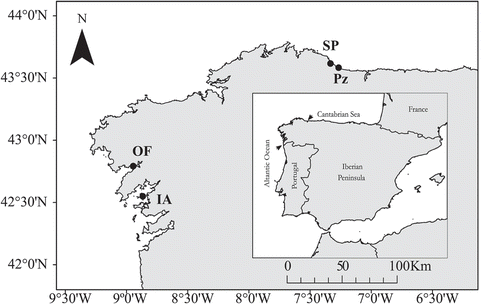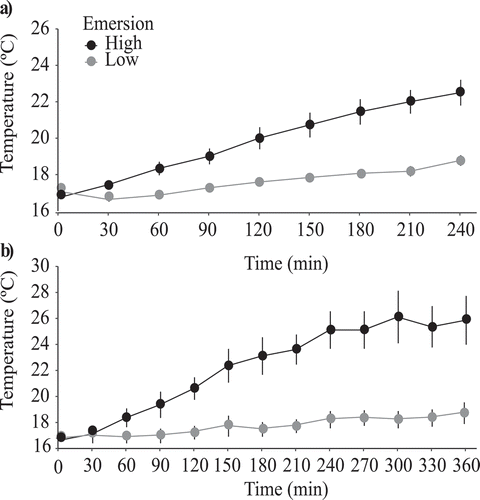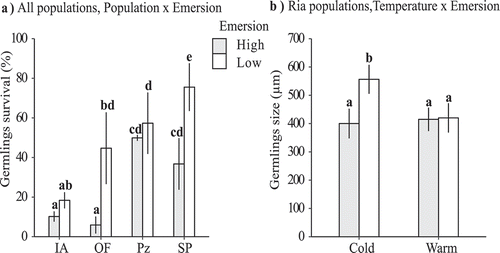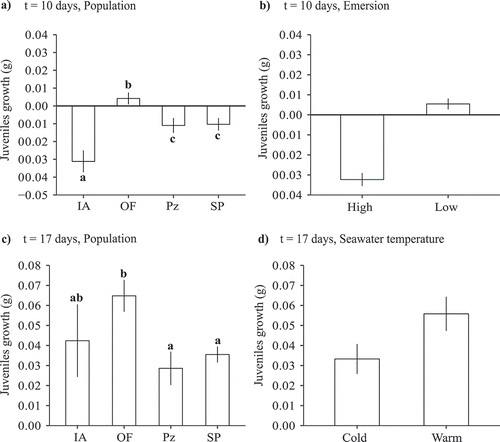Figures & data
Fig. 1. Study locations on the NW Iberian Peninsula (Galicia). Pz, Peizás; SP, San Pedro; OF, O Freixo (Ría de Muros); IA, Isla de Arousa (Ría de Arousa). The black arrow shows the current rear-edge distribution limits along the Iberian Peninsula

Figure 2. Air temperatures in the two emersion treatments (high and low) in the first mesocosm experiment, a) 4-hour cycle; b) 6-hour cycle. Note the different scales on the axes. Average values ± SE are shown, n = 6

Table 1. Selection of the random and fixed structures of GLMMs on survival of germlings at the end of the first mesocosm experiment from a) rias populations and b) all populations. For the random structure, table shows likelihood ratio tests comparing different nested models. For the fixed structure, the LogLikelihood (logLik), AICc and Δi are shown for both, the subset of candidate models and the full model, and Weights (ɷi) only for the candidate models. Selected models are marked in bold. P: Population, S: Salinity, T: Seawater temperature, E: Emersion. In the fixed component, the multiplications signs (×) indicate the inclusion of all the interactions of lower order and the implicated main factors
Figure 3. Survival of germlings and final size (average values per disc) in the first mesocosm experiment. a) Survival of germlings for each combination of population and emersion (n = 6); b) final average size of germlings from the ria populations, for each combination of seawater and emersion temperature (n = 20–23). Mean values ± SE are shown. Different lower-case letters above bars indicate significant differences between means based on a posteriori Tuckey test. Population abbreviations as in

Table 2. Model selection of the random and fixed structures of LMs models on size of germlings at the end of the first mesocosm experiment from a) rias populations and b) all populations. For the random structure, table shows likelihood ratio test comparing different nested models. For the fixed structure, the LogLikelihood (logLik), AICc and Δi are shown for both, the subset of candidate models and the full model, and weights (ɷi), only for the candidate models. Selected models are marked in bold. Abbreviations as in . Null = model with no fixed structure. In the fixed component, the multiplications signs (×) indicate the inclusion of all the interactions of lower order and the implicated main factors
Table 3. Selection of the random and fixed structures of GLMMs on survival of juveniles: a) 10 days (22 September) and b) 17 days (29 September) after the start of the mesocosm experiment. For the random structure table shows likelihood ratio tests comparing different nested models. For the fixed structure, the LogLikelihood (logLik), AICc and Δi are shown for both, the subset of candidate models and the full model, and weights (ɷi) only for the subset of candidate models. Null= model with no fixed structure. Selected models are marked in bold. Abbreviations as in . In the fixed component, the multiplications signs (×) indicate the inclusion of all the interactions of lower order and the implicated main factors
Fig. 4. Survival of juveniles in the first mesocosm experiment. a) Survival over time for each combination of population and emersion treatment (n = 16); b) survival of juveniles 10 days after the start of the experiment for each combination of seawater and emersion temperature (n = 16); c) survival of juveniles 17 days after the start of the experiment for each combination of population and emersion treatment (n = 4). In a) mean values and the smallest and largest SE bars are shown; in b) and c) mean values ± SE are shown. Different lower-case letters above bars indicate significant differences between means based on Tukey post hoc test. Population abbreviations as in

Table 4. Selection of the random and the fixed structures of LMMs on growth of juveniles: a) 10 days (22 September) and b) 17 days (29 September) after the start of the mesocosm experiment. For the random structure table shows likelihood ratios test comparing different nested models. For the fixed structure, the LogLikelihood (logLik), AICc and Δi are shown for both, the subset of candidate models and the full model, and weights (ɷi) only for the candidate models. Selected models are marked in bold. Abbreviations as in . In the fixed component, the multiplications signs (×) indicate the inclusion of all the interactions of lower order and the implicated main factors
Figure 5. Growth of juveniles in the first mesocosm experiment. a) Growth (difference in final and initial fresh weights) 10 days after the start of the experiment for each population (n = 67–79); b) growth 10 days after the start of the experiment for high and low emersion treatments (n = 140–157); c) growth 17 days after the start of the experiment for each population (n = 37–23); d) growth 17 days after the start of the experiment for cold and warm seawater temperatures (n = 63–64). Mean values ± SE are shown. Different lower-case letters above bars indicate significant differences between means based on a Tukey post hoc test. Population abbreviations as in

Table 5. Selection of the best linear model on survival and growth of recruits from rias populations in the post-stress experiment for: a) survival of recruits, b) initial size of recruits and c) final size of recruits. The table shows the LogLikelihood (logLik), AICc, Δi and AICc weights (ɷi). Selected models are marked in bold. Abbreviations as in
